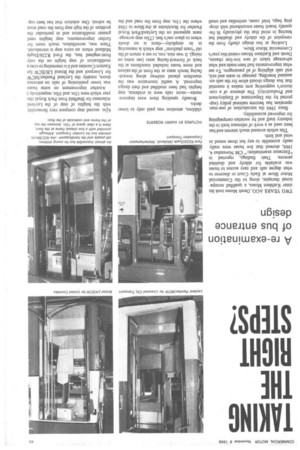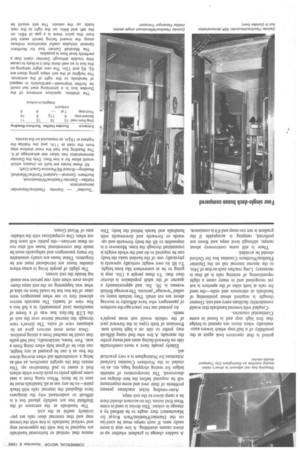TAKING THE RIGHT STEPS?
Page 47

Page 48

If you've noticed an error in this article please click here to report it so we can fix it.
A re-examination of bus entrance design
TWO YEARS AGO, Derek Moses took his sister Kathleen Moses, a qualified occupational therapist, along to the Commercial Motor Show at Earls Court to discover to what degree safe and easy access to buses was available for elderly and disabled persons. Their findings, reported in "Entrance examination:" CM November 4, 1966, showed that few buses were really easily accessible to any but those sound in wind and limb.
This article aroused much interest and has been used as a work of reference both in the industry itself and by societies campaigning for improved accessibility.
Since 1966 the introduction of one-man operation has become national policy (supported by the Department of Employment and Productivity). The absence of a conductor's supporting arm makes it essential that bus design should allow for the safe unassisted boarding, passage to seats and exit, and safe alighting of all passengers. To see what improvements had been made and what advantage taken of new low-line chassis, Derek and Kathleen Moses visited this year's Commercial Motor Show.
Looking at bus design chiefly from the viewpoint of the elderly and disabled but bearing in mind that the physically fit frequently board buses encumbered with shopping bags, brief cases, umbrellas and small children, attention was paid only to lower decks.
Broadly speaking there were improvements—more rails were in evidence, step heights had been modified and their design improved. A useful innovation was the stanchion placed midway along inwardfacing bench seats at the front of the saloon and more buses included stanchions at the back of forward-facing seats (see notes on rising). It was nice, too, to see a return of the old "tram platform" step which is reassuring in its simplicity—there is no doubt where to place one's feet. (This step arrangement appeared on the Leyland/Park Royal Panther for Stockholm at the Show in 1966 where the 1 lin, step from the road and the second step compare very favourably with the heights of step of the Leyland Atlantean for Sheffield from Park Royal this year which were 15in. and 10in. respectively.) Another improvement on some buses was lower positioning of rails on entrance doors, notably the Leyland Panther/MCW for Liverpool and the Bristol LH/ECW for Eastern Counties and it is interesting to note a modification of step height on the only front-engined bus, the Ford R226/Duple Midland where an extra step is introduced. There was, nevertheless, much room for further improvements; step heights need greater modification and in particular the problem of the high step from the road must be solved. One solution that has been sug gested is that operators look again at the possibility of a half-step which lowers automatically when doors are opened to bridge that first high step and is found in some Continental countries.
Coupled with lowered handrails this would considerkbly facilitate entry and exit. Greater thought is required about positioning of handrails at entrances and exits—the need for rails at both sides of the aperture is not yet recognised and in many cases a slight repositioning of existing rails is all that is necessary. Long reaches such as that of 34in. to the nearest internal rail on the Daimler Fleetline/Northern Counties bus for Oxford should be avoided.
There is still some controversy about ramps; although level steps and floors are preferred, ramping is acceptable if the gradient is not too steep and if it is consistent. A sudden change in gradient whether up or down causes stumbling. A low step is more easily seen. If such ramps must be used (as on the Daimler/Fleetline/Park Roypl for Manchester) they ought to be defined by a change in colour. This device is used in some West-End stores. On no account should there be a ramp down to the exit steps.
Auto-vending ticket machines present problems of their own and some experiment will be required before the best designs are discovered. The incorporation of suitable ledges for resting shopping bags, etc. as included in the Northern Counties Leyland Atlantean for Nottingham is a very practical aid.
Elderly people have a more comfortable ride on forward-facing seats and many prefer the nearside. A few who find rising difficult may prefer to ride on a high bench seat. Provision of both types in the forward part of the vehicle would suit most people's needs.
As pointed out two years ago the numbers of passengers who have difficulty in moving about are not small. They include many so called "average" persons. The average British woman is 5ft. 3in. and approximately a quarter of the adult population is shorter than that. To these people a 15in. step is going to be at somewhere like knee height. To lift its own weight vertically upwards is physically one of the hardest tasks the body can be required to do and the whole weight is transmitted through the knee. Moreover it is impossible to lift the body forwards and upwards or forwards and downwards with handrails and hands behind the body. This
means that vertical or horizontal handrails are required in line with the uppermost step and vertical handrails in line with the lowest step and that external door rails are particularly useful at the exit.
The handrails at the entrance of the Sheffield bus are usefully placed but it is difficult to understand why the designers have disguised the internal rails with black paint—to be any use at all, handrails must be seen to be there. When rising from a seat some people prefer to push down while others find it easier to pull themselves up. This means that the upright stanchion, as well as being a considerable aid when moving down the bus as it can be grasped at any height, can also be of great help when rising from a seat. Few buses, incidentally, had bell-pulls that could be reached from a sitting position.
Once more most mirrors gave an inadequate view of exits. The driver's view through the internal mirror over the exit of the LTB flat-fare bus was of a forest of stanchions (and presumably in a full bus a fine view of heads). The nearside mirror allowed him to see when passengers were clear of the bus but he could have no idea of what was happening on the exit steps themselves even when only one person was standing beside the exit screen.
The plight of people living in areas where standee buses are introduced must not be forgotten. These buses are totally unsuitable for many passengers and safeguards must be made that conventional buses will also run on these services—the public will soon find out when. One sympathizes with the inhabitants of Wood Green.




























































































































































